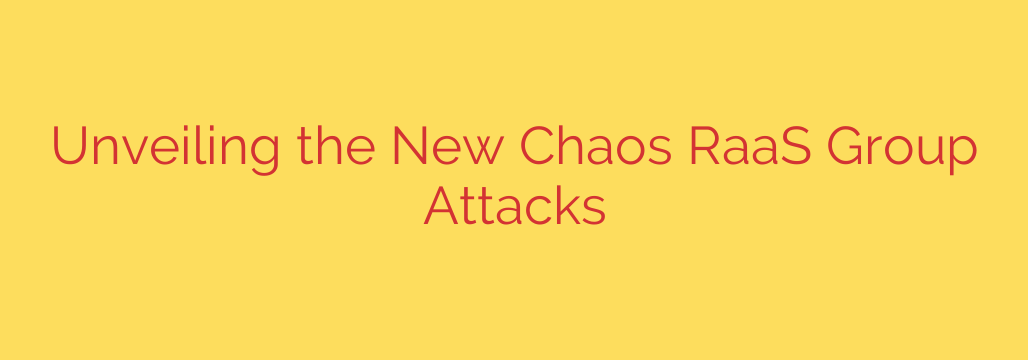
Chaos Ransomware: The Destructive New Threat in the RaaS Landscape
The cybersecurity landscape is constantly evolving, with new threats emerging that challenge even the most prepared organizations. A particularly dangerous development is the rise of the Chaos ransomware group, a threat actor that leverages a deceptive and destructive model to cause maximum damage. This isn’t just another ransomware variant; it represents a significant shift in attack methodology that every business leader and IT professional needs to understand.
At its core, Chaos is not just a single malware but a complete Ransomware-as-a-Service (RaaS) platform. This means the developers of the malware don’t necessarily carry out the attacks themselves. Instead, they license their malicious software to other cybercriminals, known as affiliates, who then launch attacks against various targets. This model dramatically lowers the barrier to entry, allowing even less-skilled actors to deploy sophisticated and devastating cyberattacks.
More Than Ransom: A Deceptive and Destructive Tool
What truly sets Chaos apart is its malicious deception. While it presents itself as typical ransomware by encrypting files and demanding payment, its underlying function is often far more sinister. Security researchers have discovered that many versions of the Chaos malware don’t actually encrypt the files for a potential future decryption.
Instead, many Chaos variants act as “wipers,” permanently destroying or corrupting data beyond recovery. The ransomware note and the demand for payment are a smokescreen. The attackers may have no intention or ability to restore the files, even if the victim pays the ransom. Their primary goal is disruption, destruction, and chaos—living up to the platform’s name.
This wiper functionality makes paying the ransom a futile exercise. Victims who pay in the desperate hope of recovering their critical data are often left with nothing but a lighter bank account and the same permanently lost files.
How a Chaos Ransomware Attack Unfolds
Chaos affiliates use a variety of common tactics to gain initial access to a victim’s network. These methods often include:
- Phishing Emails: Crafting convincing emails that trick employees into clicking malicious links or downloading infected attachments.
- Compromised Credentials: Using stolen usernames and passwords, often purchased from the dark web, to log into corporate systems.
- Exploiting Vulnerabilities: Scanning for and exploiting unpatched security flaws in public-facing software and systems.
Once inside, the malware begins its destructive process. It seeks out valuable files across the network—documents, databases, backups, and more. The payload then either encrypts or, more likely, overwrites the files with random data, rendering them useless. A ransom note is then left on the infected systems, creating the false impression that recovery is possible.
Actionable Security Tips to Protect Your Organization
Defending against a threat as destructive as Chaos requires a proactive and multi-layered security strategy. Waiting until an attack occurs is too late, especially when the data may be unrecoverable.
Here are essential steps every organization must take:
Implement a Bulletproof Backup Strategy: This is your single most critical defense. Follow the 3-2-1 rule: maintain at least three copies of your data, on two different types of media, with one copy stored securely offsite and offline. Regularly test your backups to ensure they can be restored successfully.
Strengthen Employee Security Awareness: Your staff is your first line of defense. Conduct regular training to help them identify and report phishing attempts, suspicious attachments, and other social engineering tactics.
Enforce Multi-Factor Authentication (MFA): Stolen credentials are a top attack vector. MFA provides a crucial layer of security that can block an attacker even if they have a valid password. Enforce it on all critical accounts, especially email, VPN, and administrative access.
Prioritize Patch Management: Cybercriminals are experts at finding and exploiting known vulnerabilities. Maintain a rigorous patch management program to ensure all operating systems, applications, and network devices are kept up to date with the latest security patches.
Utilize Advanced Endpoint Protection: Traditional antivirus is no longer enough. Deploy an Endpoint Detection and Response (EDR) solution that uses behavioral analysis to detect and block malicious activities characteristic of ransomware and wipers before they can execute.
Segment Your Network: By dividing your network into smaller, isolated segments, you can contain a breach and prevent malware from spreading laterally from one system to the entire organization.
The emergence of destructive RaaS platforms like Chaos underscores the importance of a defense-in-depth security posture. By focusing on proactive prevention and robust recovery plans, you can significantly reduce your risk and ensure your organization remains resilient in the face of these evolving cyber threats.
Source: https://blog.talosintelligence.com/new-chaos-ransomware/








